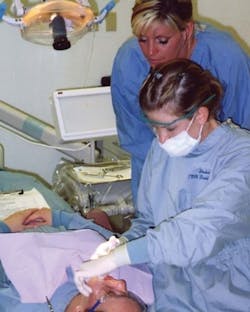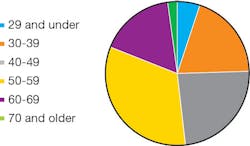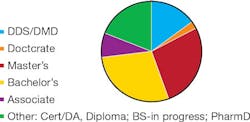Transitioning to dental hygiene educator: Resources can help recast a career into a faculty position
By Laura J. Webb, RDH, MS, CDA
Decades ago, when the dental hygiene profession was experiencing a growth spurt, many experienced clinicians, after earning their advanced degrees, entered dental hygiene education and remained there. Since that time, there has been a decline in new dental hygiene educators.1 Now, dental hygiene educators are aging, and it is expected that the reported faculty shortage in dental hygiene education will continue to rise. The American Dental Educators’ Association (ADEA) Allied Directors’ Survey, conducted in 2014, revealed that approximately 50% of the dental hygiene faculty workforce is age 50+ (see Figure 1). It also predicted that over the next five academic years, there could be 292 retirements that will lead to lost and vacant positions in dental hygiene education. It also reported that 66.9% of dental hygiene faculty were part-time positions.2,3 It would seem that the door of opportunity to transition from clinician to educator is wide open!
Dental hygiene educators continue to work in a variety of settings, including online, in the classroom, laboratory, clinics, at universities, colleges, and technical institutions. However, the dental hygiene education programs of today are not the same as those of yesteryear. They have evolved, as they must, to meet the needs of an ever-evolving profession. The dental hygiene profession has expanded from disease prevention specialist to a variety of roles including “improving the public’s oral and overall health.”4 The complexity of oral health, expansion of settings to address access-to-care issues, technology, accreditation standards, and the importance of interprofessional collaboration (IPC) are just a few of the drivers of change in dental hygiene education.
The seasoned clinician brings valuable clinical expertise and practice perspective to education programs. However, working within the educational paradigm requires some adaptation and learning of new skills. Clinical practice experience alone is not enough to transition into education, but it is a good start! Transition, as with any new endeavor, requires thoughtful research, exploration, and education.
Steps to success
Assessment
Ascertain qualities effective instructors share and cultivate them. Note that many of these qualities are also essential for successful clinical practice. Examples of these qualities are team player, enthusiastic, flexible, respectful, organized, sense of humor, ability to build rapport, and ability to view issues from multiple perspectives.
Also, research the requirements for faculty. Qualifications, especially preferred qualifications, can vary quite a bit between institutions, but the American Dental Association (ADA) Commission on Dental Accreditation (CODA) has established minimum qualifications for dental hygiene faculty in Dental Hygiene Standard 3.7 (see sidebar).5 Determine specific degree requirements for programs you are interested in.
Common minimum requirements for full-time faculty usually include:
- BS degree (or higher). Although some programs hire seasoned clinicians who hold associate degrees to share their expertise part-time in clinic, full-time positions and all didactic/theory positions require at least a bachelor’s degree preparation.5 Also, BSDH education programs commonly require a master’s degree as a minimum requirement for faculty due to their institutional policies.
- Graduate of a dental hygiene program accredited by ADA CODA.
- Recent clinical practice experience.
- Possession of current state (of program) license and related certificates, (if applicable, e.g., local anesthesia, N2O-O2, restorative, etc.). Some states offer a special license, designed for educators, and taking the state/regional clinical board if one holds an active license in another state or has passed another clinical board may not be required. Also, some programs will state “or eligible” in the minimum qualifications, indicating that, if hired, licensure would be required by a specified date.
- Common preferred qualifications for full-time faculty usually include:
- Master’s degree or higher (often in health-related discipline or higher education).
- College level teaching experience; traditional/online.
- Clinical experience with technology.
- Current knowledge of the specific subjects they are teaching.
- Educational methodology/clinical educational methodology.
- Ability to work collaboratively with colleagues, administrators, students, other health-care providers, and stakeholders.
- Demonstrated sensitivity to cultural diversity, SES, disability, ethnic backgrounds.
- Computer literacy skills, MS Office.
- Excellent instrumentation skills.
Sometimes, the “preferred” qualifications listed above are written as “minimum” qualifications, depending upon the institution, although doing so can limit the pool of applicants. In addition, some programs require certain “essential functions” that are specific to the needs of their program/institutional setting. Figure 2 provides a snapshot of the highest degrees earned by the dental hygiene faculty surveyed in 2014.2
Always be learning
Find a mentor - An educator who teaches at a nearby dental hygiene program or, perhaps, a professor at the program you graduated from may help guide you through the process of transitioning between clinical practice and education.
Observe teaching - Ask a dental hygiene program director if you can observe experienced clinical and didactic faculty.
Volunteer/apply for a part-time instructor position - Dental hygiene programs frequently are on a tight budget and welcome volunteers,6 but you must be willing to learn and follow program guidelines for teaching and evaluating students.
Join ADEA/attend meetings - ADEA provides a plethora of excellent resources and networking opportunities to educators and those who would like to become educators. Also, some states have their own dental hygiene education associations, which provide educational and networking opportunities. In addition, the ADHA website provides links to information about dental hygiene education and the ADHA Annual Conference provides special programs for educators.6
Take educational methodology course(s) - Educational (teaching) metho dology courses provide important information and insight to teaching. There are numerous opportunities which range, widely, in course length and cost.6
Check with your local dental hygiene program and dental hygiene education association for additional opportunities for these courses in your area. BSDH completion and MSDH programs often include educational methodology as part of the curriculum. There are several education companies that offer onsite stand-alone courses. Since CODA requires background in current educational methodology concepts, it is logical to have courses/experiences related to educational methodology reflected in your CV/resume. Some online resources for courses are DentalCare.com’s “Strategies for Developing a Quality Course” (a free two-hour introductory course) and ADEA.org’s ADEA/Colgate/AAL Institute for Allied Health Educators (IAHE) program for new educators.
Learn about interprofessional education (IPE) - IPE is an important topic and has been incorporated into the dental hygiene curriculum. Briefly stated, it is a process by which students from a variety of health-care emphases learn to collaborate as a team to evaluate and implement treatment with the goal of improved patient outcomes.7 Including the IPE content in the curriculum supports the CODA requirement: “Graduates must be competent in communicating and collaborating with other members of the health care team to support comprehensive patient care” (Dental Hygiene Standard) 2-15.5
Remain current in terminology, concepts, and trends - Read dental hygiene journals, magazines, and other related publications. Current editions of textbooks can be purchased - new, used, or even rented - through college bookstores and at Amazon.com. I continuously purchase current editions, particularly related to the subjects I teach. I have been very pleased with the excellent condition of new-edition used textbooks.
Earn advanced degrees - As discussed below, degrees can be earned in a variety of ways while still working in clinical practice or education, and there are many opportunities for financial aid and student loans.
Consider, too, that there is growing support to require the BSDH degree as entry to practice for the profession.8 Therefore, it is foreseeable that there may be a higher demand for master’s prepared (and higher) educators in the future.
If you are very near completion of your BS in a related field, consider finishing it. If not, there are many degree-completion programs (BSDH) (visit ADHA.org or ADEA.org) that are designed for dental hygienists who are licensed to practice and hold an associate’s degree or certificate in dental hygiene. Courses may be entirely online, only on-campus, or a blended approach of online and onsite classes.
Earn a master’s degree in dental hygiene in higher education or another related field. Both the ADHA and ADEA offer links to related resources. Courses may be entirely online, only on-campus, or a blended approach of online and onsite classes.
Forsyth School of Dental Hygiene provides an excellent opportunity to “build on your previous associate’s degree to advance to a master’s degree without first earning your bachelor’s degree.” It is “the nation’s first and only bridge program offered entirely online on a full- or part-time basis for working hygienists.” This is an important opportunity for hygienists that helps to eliminate discouragement from thinking that they must earn a bachelor’s and then proceed to a master’s. Visit mcphs.edu for more information.
Final thoughts
I admit it: I love academia! As much as I truly loved working in a variety of clinical practice settings for the first 18 years of my professional career, the transition into academia and other educational settings for the last 19 years has been a high point of my career. It has allowed me to apply my skills in new ways while continuing to learn from both students and peers, and I can still work part-time in clinical practice. I feel a sense of pride in helping others to succeed.
If you are interested in advancing the art and science of dental hygiene, improving quality of care, and positively impacting the landscape for future health care, all while refining and improving your own skills, dental hygiene education may be a great opportunity for you. The rewards are truly great. RDH
Laura J. Webb, RDH, MS, CDA, is an experienced author, clinician, educator, and international speaker who was the founding director of the TMCC Dental Hygiene Program in Reno, Nevada. She owns LJW Education Services (ljweduserv.com), which provides educational methodology courses and accreditation consulting services for dental hygiene education programs and CE courses for clinicians. Laura frequently speaks on the topics of local anesthesia and nonsurgical periodontal instrumentation. She has written and reviewed numerous professional publications and writes a bimonthly column on anesthesia for RDH magazine. Laura was recipient of the 2012 ADHA Alfred C. Fones Award. She can be reached at [email protected].
ADA CODA Dental Hygiene Standard 3.75
“The full-time faculty of a dental hygiene program must possess a baccalaureate or higher degree.
Part-time faculty providing didactic instruction must have earned at least a baccalaureate degree or be currently enrolled in a baccalaureate degree program.
All dental hygiene program faculty members must have:
- Current knowledge of the specific subjects they are teaching.
- Documented background in current educational methodology concepts consistent with teaching assignments.
- Faculty who are dental hygienists must be graduates of dental hygiene programs accredited by the Commission on Dental Accreditation.”
References
1. Lamoreux DJ. Who will be teaching? The future of dental hygiene education threatened as shortage looms. RDH. 2014;34(7).
2. American Dental Education Association. (June 2015). ADEA Survey of Allied Dental Program Directors, 2014 Summary and Results. Washington, D.C.
3. Stolberg R. Responding to the looming faculty shortage in allied dental education. American Dental Education Association webinar. online April 28, 2015. http://www.adea.org/facultyshortage/.
4. Transforming Dental Hygiene Education and the Profession for the 21st Century. White paper. American Dental Hygiene Association. Published 2015. http://www.adha.org/adha-transformational-whitepaper.
5. (2016) Accreditation Standards for Dental Hygiene Education Programs. Commission on Dental Accreditation. Effective January 1, 2013. Last revised February 2017. http://www.ada.org/~/media/CODA/Files/dh.pdf?la=en?123.
6. Clarke T. Should you become a dental hygiene educator? Modern Hygienist. February 08, 2017. http://www.dentalproductsreport.com/hygiene/article/should-you-become-dental-hygiene-educator.
7. Navickis MA, Mathieson K. U.S. dental hygiene students’ perceptions of interprofessional collaboration. J Dent Educ. 2016;80(9)1041-1048.
8. Rogers C, Johnson TB, Gurenlian JR. New York State dental hygienists’ perceptions of a baccalaureate degree as the entry-level degree required for practice. J Dent Hyg. 2015;89(Suppl 2):13-21.



